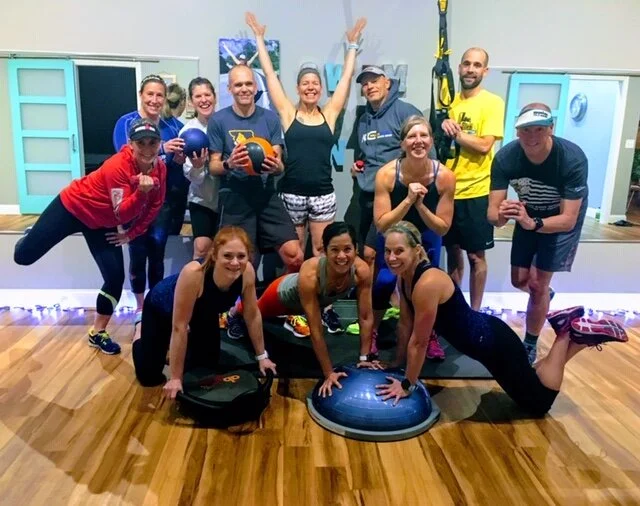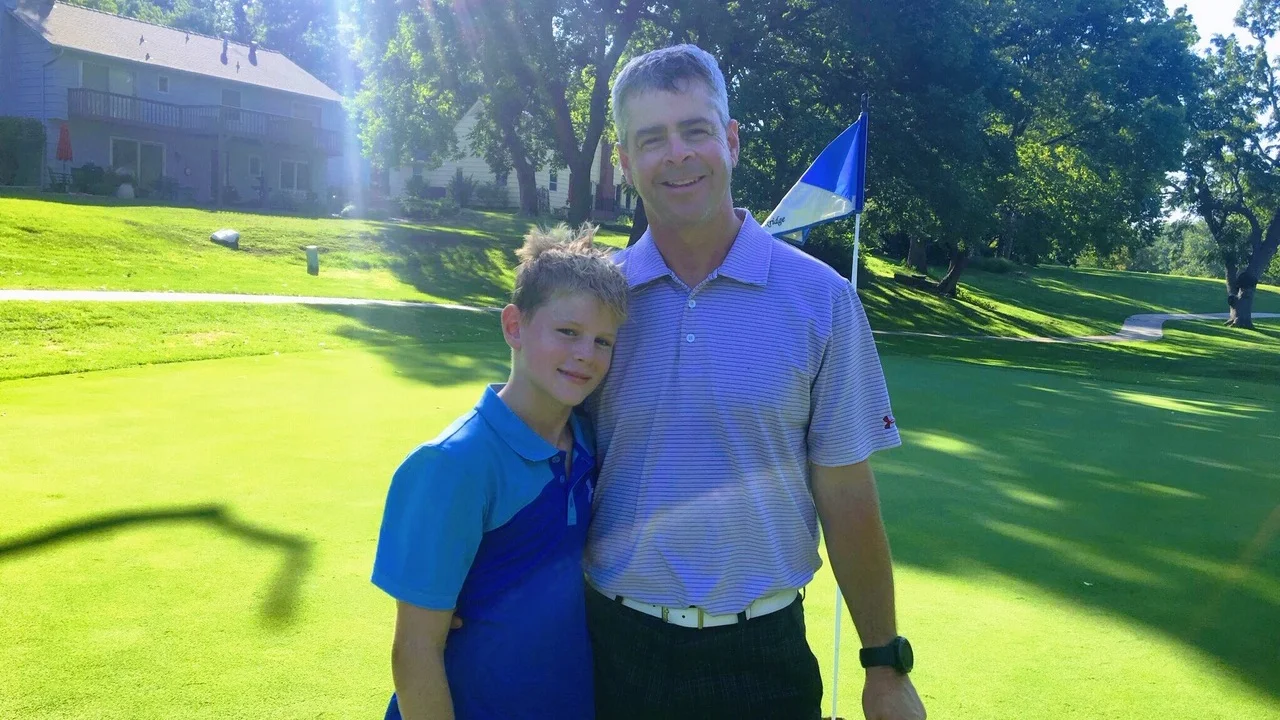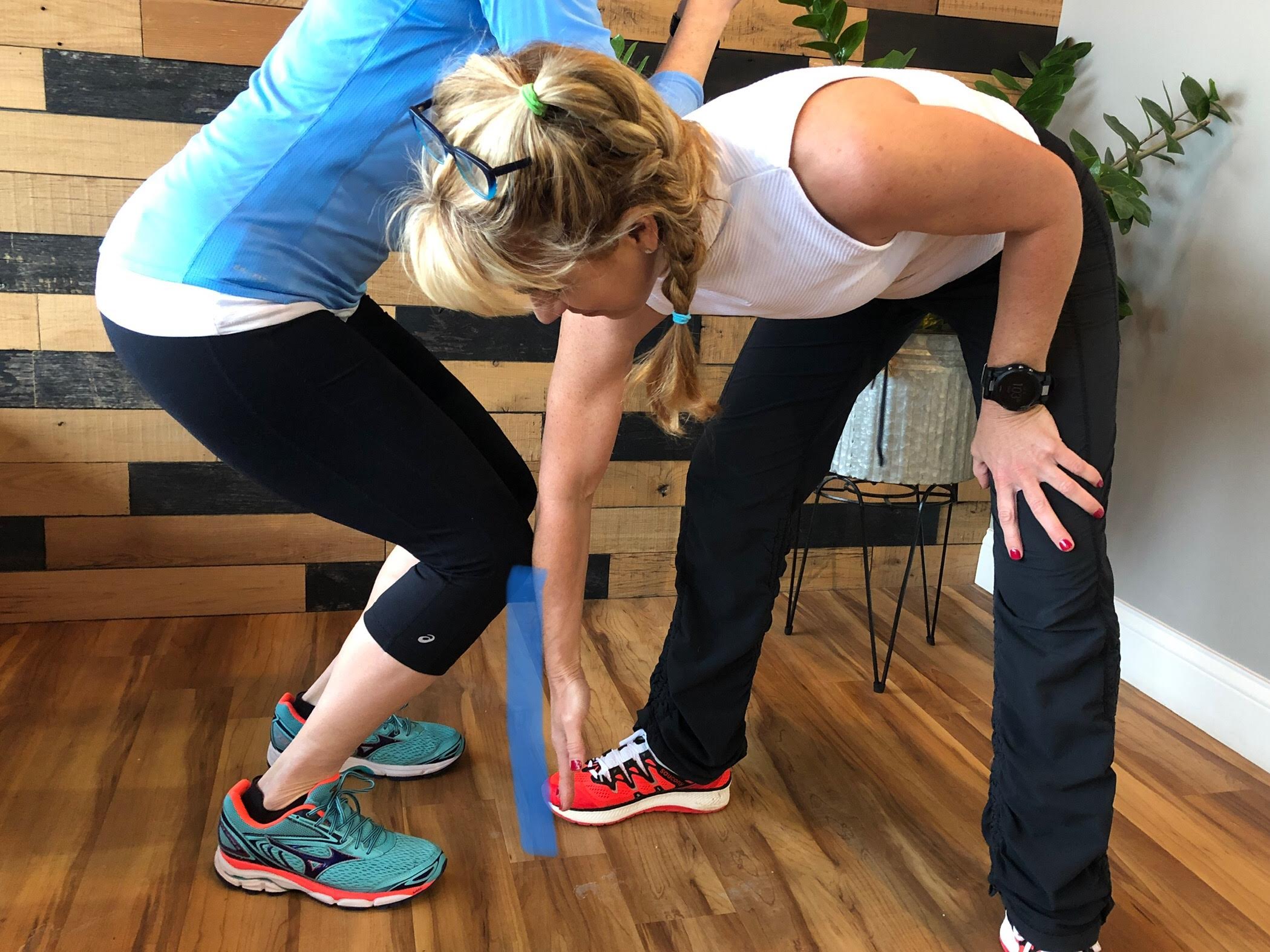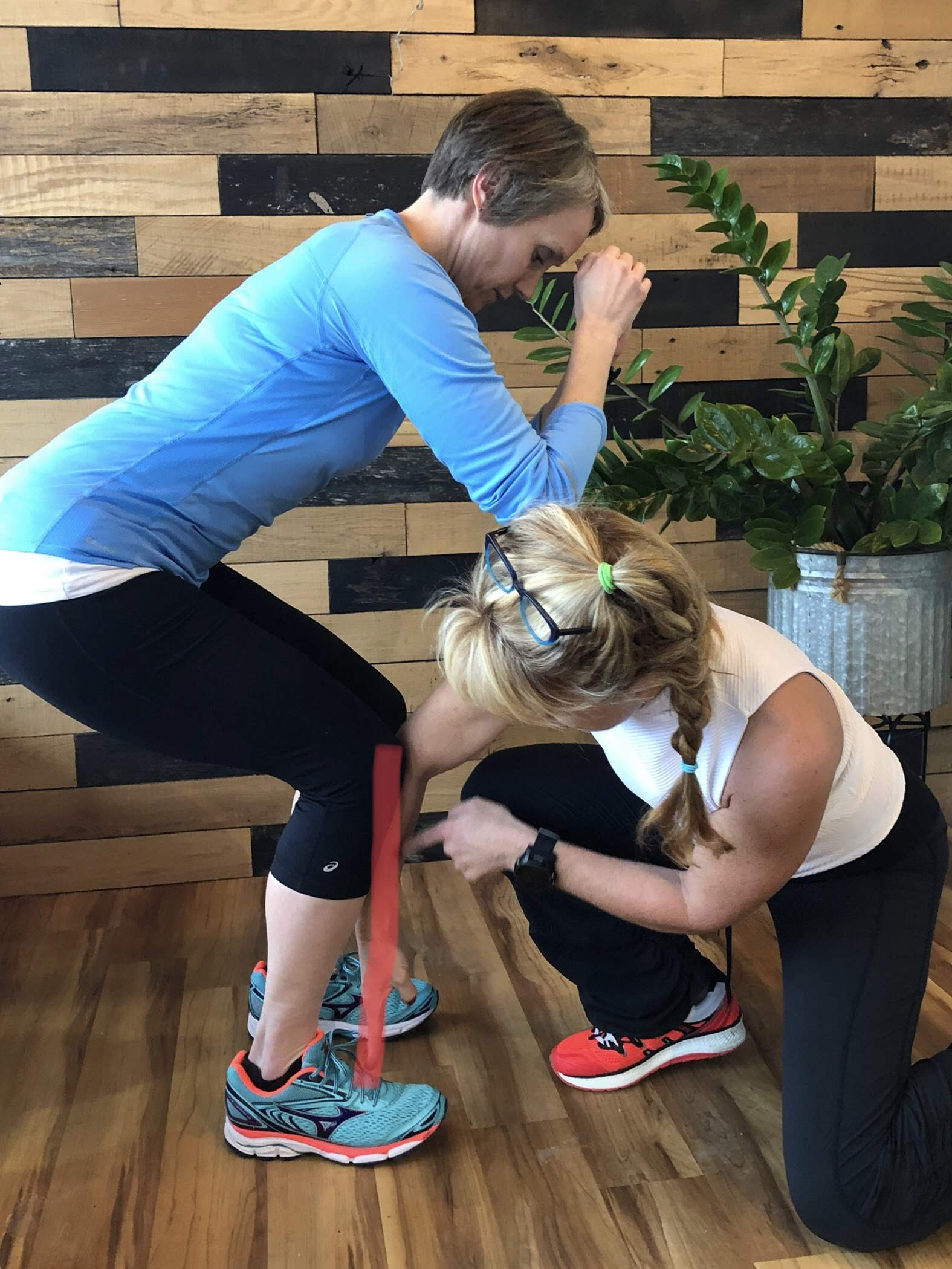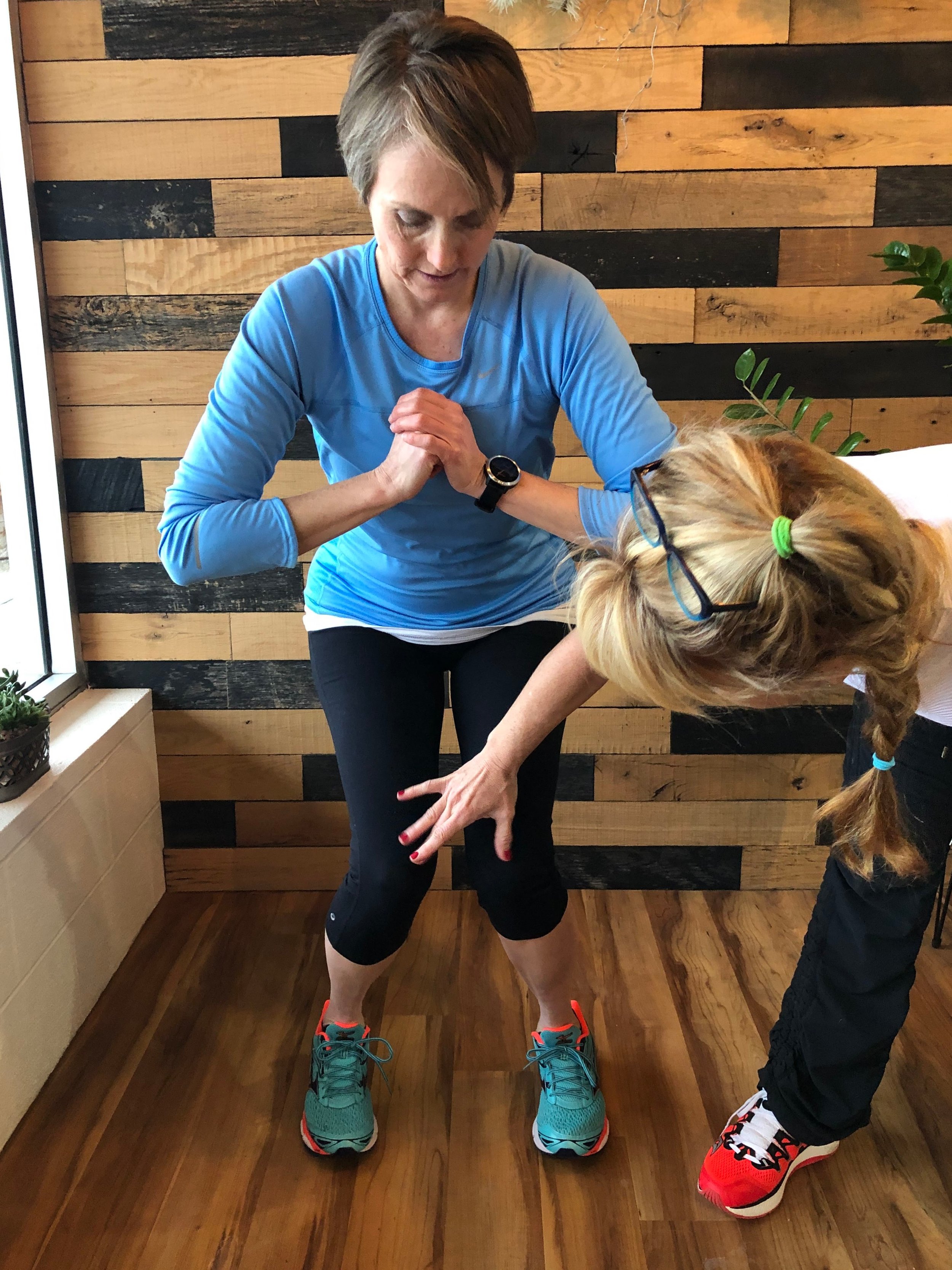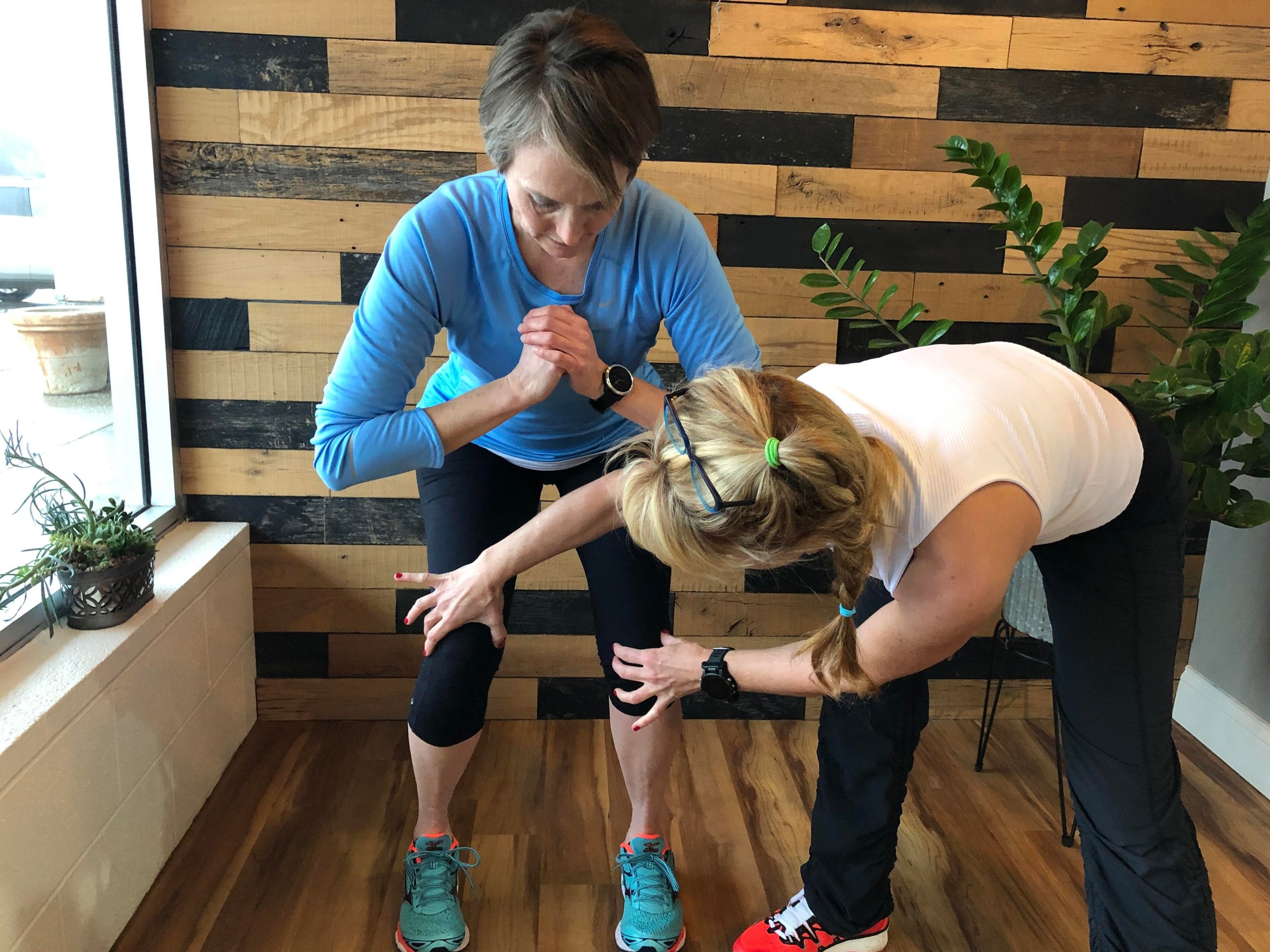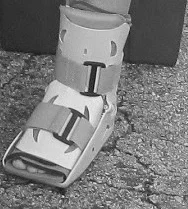Inflammation Part Two: How to Break the Vicious Cycle of Chronic Inflammation
In our article, Inflammation Part One: Aid and Control Early Inflammation, we discussed the benefits of early inflammation and the importance of controlling it. When inflammation of the musculoskeletal system is unchecked and persists longer than 2 weeks, a vicious cycle ensues. See photo above.
Inflammation causes pain which leads to inhibition and loss of function which leads to more injury, and that feeds right back into inflammation and pain. It becomes a never-ending loop. To break this cycle, Coach Amy uses a combination of neurological dry needling, Active Release Technique, and gentle mobility exercises.
It is not enough to simply stop the cycle. The cause of the problem is often unclear. Many overuse injuries are complex. Even acute ones, like a sprained ankle, can be the result of a dysfunctional gait or biomechanics. Coach Amy thoroughly evaluates patients to determine the root cause of the injury.
It’s a lot like putting together a puzzle that has pieces missing.
Coach Amy works one-on-one with patients throughout the entire rehabilitation process.
“I continually assess at each visit because, more often than not, each issue has many layers. For the best and quickest outcome, we must adapt the treatment approach as we go.”
Remember, as we discussed in Inflammation Part One: Aid and Control Early Inflammation, inflammation gets a bad rap: controlled inflammation actually benefits recovery. But untreated, inflammation can begin a nasty, never-ending loop of chronic pain. When possible, seek treatment for pain and injuries early to benefit from the positive impacts of inflammation without entering the chronic pain cycle.
Healthy to the Core
Most of us have heard the buzz words, “strong core.” Is it worth all the hype? Yes! A strong core is beneficial for everyone not just athletes; it can help prevent pain and injury in any lifestyle. Ring a bell from the trifecta articles in October?
Mobility: A Key to Pain-Free Functional Movement and Injury Prevention
Completing the Trifecta to Pain-Free Function and Injury Prevention: Proprioception
We can prevent injury with a strong core; it improves our stability, agility, balance, posture, and coordination creating a foundation for a stronger and healthier body. It also improves efficiency with movement; we gain more power and function from our upper and lower extremities. For endurance athletes, this translates to more power in arm and leg movements while running, swimming, and cycling. For non-athletes this translates into preventing back pain from overuse strains doing household or work related tasks.
Contrary to popular belief, a strong core isn’t limited to strong abs. Our core encompasses the entire cylindrical column of muscles ranging from above the shoulders to below the hips. The proper way to engage and strengthen this range of muscles is with slow, intentional and controlled, quality movement patterns.
Coach Amy has designed a core strengthening class for both beginners and advanced athletes. These classes incorporate a combination of progressively challenging dynamic and functional exercises to build control for activities of daily living and sport.
Our Phoenix Core Winter session is 8- weeks long and begins January 7th. Classes are held at CoachAmyPT on Tuesdays at 6:00 p.m. Commit to feeling stronger, moving better, and preventing injury in the New Year. Spots are limited!
Inflammation Part One: Aid and Control Early Inflammation
Most of us believe inflammation is detrimental. But the truth is, inflammation is the body’s healthy reaction to injury and disease. The body releases critical substances that stimulate the body to repair, heal and fight off disease.
Inflammation is a natural defense mechanism that increases blood flow to the injured area. Blood flow carries in white blood cells for repair and transports dead, injured cells away. This process usually take 8-10 days once the stimulus for injury is eliminated. Sometimes the source of injury is obvious, like a sprained ankle, but some sources can be elusive. It could be poor posture, repetitive motions or dysfunctional mechanics in the workplace, hobby or sport. Coach Amy helps identify tricky sources of injury and modifies activity to prevent additional tissue damage.
Patients can initiate early control with ice in the first 24 hours of injury. Moist heat after the first 24 hours with compression and elevation can help the blood flow. The benefits of NSAID's and over-the-counter anti-inflammatories are controversial. While they can help control pain, they can also interfere with the powerful early healing process associated with inflammation.
Coach Amy uses dry needling techniques to enhance and control the early inflammatory process. While acute (early) inflammation benefits the body, lingering inflammation can be harmful. Check out next week's post to learn more about identifying and combating harmful, persistent inflammation.
Does Coach Amy Treat Back Pain? Why, Yes!
Back pain can affect people of all ages. Up to 80% of the population will experience back pain at some time in their lives. Small aches and pains often come along with age, major life events, or increased and varied activity; but sometimes we have no idea what triggers pain at all.
Coach Amy helps identify triggers and provides treatment for patients with back pain that interferes with work, sleep, everyday tasks and hobbies. More importantly, once pain and function is restored she helps patients develop a strategy to prevent future occurrences.
Anna, a CoachAmyPT patient, suffered from back pain at various stages of her adult life. “I was experiencing severe lower back pain while training for a half marathon, any time I ran longer than 6 miles or so. It didn't hurt while I was running, but the day after I'd run it would hurt so much I'd be in tears. I had shooting pain down my hips and legs too.
I started seeing Amy for physical therapy sessions, including Active Release Therapy (ART) and a lot of strength training. It made a HUGE difference for me. After a couple of sessions I was mostly pain free, and I was able to continue to run and train for my half marathon.”
After the arrival of her first baby, Anna’s lower back and hip pain returned. “The lower back pain ‘post-baby’ was similar - shooting pain in my hips wrapping around to the front. At first it started as an annoyance. When the pain peaked, making my daily tasks like rocking or nursing my baby really uncomfortable, I finally decided to go get treatment.”
With more ART and functional exercises, Coach Amy was able to help Anna eliminate lower back and hip pain, and slowly get back to running. They also worked together on a long-term training plan to prevent future flair-ups. “Amy is so sweet and knowledgeable - she always reassured me that it would get better, and it did. She is the best!”
Coach Amy’s patients graduate from PT armed with a better understanding of the causes of their pain and a personalized plan that may include home exercises to help prevent injury in the future. And yes, she does treat back pain!
Physical Therapy or Surgery?
Ever been doing something you love with your kids, like shooting hoops or playing catch, and injury or pain strikes? You’re not alone! Repetitive motion over and over again can take its toll on joints and muscles, especially as we age. Muscle and joint damage that was a minor problem in our younger days can resurface as a major issue.
Most people want get back to “normal” life as quickly as possible and some perceive surgery as the quickest or only route to recovery, but it has its associated risks and is expensive. Is there an alternative to surgery? A way to eliminate pain and return to a full active lifestyle? Yes! Physical Therapy.
CoachAmyPT patient, Kirk E., a former pitcher, wanted to avoid surgery on his shoulder, "The pain in my shoulder began as a gradual soreness, but over a period of a few months the pain became more intense...and the lack of mobility kept me from playing golf and catch with my boys. It eventually got so bad that I had a difficult time sleeping and getting dressed.
An orthopedic doctor diagnosed my issue as Adhesive Capsulitis or Frozen Shoulder and recommended two options: Physical Therapy or arthroscopic surgery to clean it out. I decided to go the PT route first as I wanted to avoid surgery at all costs.
The first phase of my treatment with Amy was [mobilizations]. These sessions were painful, but my mobility improved after almost each session. After I regained some of my mobility we moved onto Active Release Therapy and a lot of...exercises that I did at her office and at home in between appointments.”
After a series of physical therapy treatments with Coach Amy including ART (Active Release Therapy), Kirk was able to regain “pain-free” mobility in his shoulder completely eliminating the need for surgery. "The pain and mobility issues have not come back. I still periodically do some of the...exercises she taught me to prevent any reoccurring issues.”
Kirk returning to doing what he loves with his kids.
A thorough evaluation is necessary to determine whether physical therapy can help prevent surgery. Each patient is unique and therefore treatment plans and effectiveness can vary. Considering PT treatments as an alternative to surgery?
Power of "The Walk"
When I suggest an athlete walk for cross training or an injured runner walk in lieu of a run, they typically respond with a furrowed brow and the stink eye. I get it. For most runners, walking is akin to quitting; it feels like a failure. It certainly doesn’t come with the same post workout Serotonin high, but hear me out. Walking is running’s first cousin. The mechanics are very similar with two major differences: at least one foot stays on the ground and there is no jump. These two factors considerably minimize the strain on the joints.
Walking Benefits for Runners:
Recovery during and between workouts and races.
Adding volume safely for new runners.
Alternative for injured runners.
Cross training for healthy runners.
I didn’t personally experience the benefits of walking during my training season until recently. Last year, whilst training for my first half Ironman triathlon, I bought a puppy. Everyone told me, “It’s never a good time to buy a puppy.” At the time I was thinking this was especially dumb. Or was it? Walking the dog is important to their well-being, especially for a working breed like my Aussie.
It turns out walking also became beneficial for my well-being! I enjoyed meeting new neighbors and noticing details in nature, landscaping and architecture in a way I don’t when running by at twice the speed. Even better, I noticed a significant improvement in post workout soreness and enhanced recovery between workouts (which were sometimes two per day). With improved recovery, one minimizes injury but also enhances performance by being ready for the next workout!
There are lots of ways to add walking to your training regimen. Be sure to wear supportive footwear and use good form. Vary the terrain for maximum strength benefits. To add this to a current training regimen, consider walking a distance or time equivalent to twice that of a run distance or time (see below). Consult your coach if you need help. If you are injured, be sure to check with your physical therapist for how best to add walking to your “return to run” program.
How to Boost your Run with a Walk:
10 min of walking = 5 min of running.
Vary terrain for added strength benefits: steps, hills, technical trail.
Avoid over striding.
Wear run shoes e.g. not flip flops (you’d think I wouldn’t have to say this, but if I made that mistake, then someone else probably will).
Consult your coach if you are a new runner using walking to increase fitness.
Consult a physical therapist if you are injured and using walking as an alternative to running or as a strategy to return to sport.
Walking is highly beneficial for use in recovery, injury prevention and run strength, because it is similar to running yet less stressful on the joints. Take advantage of the “power of the walk” not just for your run health, but for your mind and soul.
Get More From a Strong Core
In today’s fitness focused world, we’ve all heard a lot of buzz around “strengthening the core.” Wondering what all of the hype is about? Having strong core muscles is beneficial for everyone, not just athletes. A strong core improves posture and stability, and can help prevent pain and injury from an active lifestyle.
With a strong core our movements are more efficient, and we gain more power and function from the upper and lower extremities. With a weak core, we are like a “rag doll”; our arms and legs move less efficiently, and energy is wasted.
For endurance athletes, a strong core translates to more power in the arm and leg swing while running, the pull and kick while swimming, and the push and pull while cycling. A strong core can help everyone prevent back pain from daily tasks such as groceries, gardening, and laundry.
Contrary to popular belief, a strong core isn’t just strong abs. Our core encompasses the entire cylindrical column of muscles ranging from above the shoulders to below the hips. The best way to strengthen these muscles is with slow, intentional and controlled, quality movement patterns. CoachAmyPT offers core strengthening classes designed for both beginners and advanced athletes.
Join us for the first Spring session of core classes beginning the week of March 4th, and feel stronger and prevent injury at work and play. Hurry, space is limited.
Watch an interview with CoachAmyPT patient, Larry, who experienced dramatic health benefits from taking Phoenix Core strengthening classes in conjunction with physical therapy.
Like our page on Facebook and Instagram for more fitness and training tips and trends.
Proper Squat or Not?
Squats have rightly earned their reputation as a great cross training exercise for athletes to increase strength especially in the glutes. However, repetitive improper squat form can result in painful overuse injuries such as tendinitis or even damage to the knee joint or behind the kneecap.
In a correct squat position, the front of your knees are parallel to each other and in line with your ankles (not your toes). In other words, most of your weight is in your heels, and you are leaning far back into an almost seated position. If you squat improperly with your knees caving in towards each other (knock knees) or with your knees extending over the front of your toes, you are significantly increasing the force on the knee and causing excessive strain. This may cause knee pain during or after exercise and could cause injury.
If you suspect your knee pain could be the result of improper squat form, rest for a couple of days. If you experience pain when you return to exercise, seek an evaluation from a medical professional. If you find the correct squat position is difficult to achieve or maintain, you can modify by holding onto a stationary object such as a bar or tabletop while squatting until you find your balance.
I’m surprised by how many people in fitness centers I see doing squats improperly. Even if you think you’re doing squats correctly double check yourself in the mirror, and make some form tweaks if necessary. After all, you want all your hard work to help you achieve success, not injury!
Hammy Strain from Running Sprints Interferes with Gymnast's Mobility
Meet Sid...she is a level six gymnast who strained her hammy in gym class doing sprints for Presidential testing. In two treatments of A.R.T. and some functional exercises (my favorite PT treatment combo) - this chick was back to full, pain free mobility with splits. Go Sid!
Steps to Address Foot Pain
"Do as I say, not as I do!" - Coach Amy.
Oh, the dreaded “plantar"! It has stopped many athletes in their tracks and certainly affects non-athletes as well, interfering with activities of daily living such as walking and standing for long periods of time.
Not all foot pain is "plantar fasciitis". Sometimes foot pain is the result of a trapped nerve, tendonosis, stress fracture, referred pain, joint sprain, arthritis, bone spur…there are number of different diagnoses.
Plantar fasciitis is a misnomer. Rarely ever is the fascia of the foot at fault. Say that three times fast! Not only is the fascia rarely involved but “itis” indicates inflammation and researchers have found that there is not a lot of evidence to support an inflammatory process with this condition.
A better name for this may be plantarmyalgia - pain in the muscles at the bottom of foot! This condition involves one or more of the tiny muscles on the bottom of the foot and/or the aponeurosis - a strong thick band of connective tissue that acts like a tendon at the bottom of the foot. These tissues act together as the “foot core”. Like the core of your trunk aids in stabilization of your spine, the foot core aids in stabilization of your lower extremity.
Pain is usually located in arch of foot and/or heel with weight bearing or push off especially in the morning, beginning of a run or after sitting for a long period and then standing up to walk. Symptoms usually improve as the day, walk or run goes on, only to worsen if up on feet all day or after running. In severe or chronic cases, pain can be constant but usually varies in intensity.
There are many different causes of "plantar fasciitis". Most often it is a combination of factors that may include but are not limited to:
tight calves
poor footwear
training error/over use
longterm use of rigid insoles/orthotics creating weak foot muscles
poor joint mobility in the middle of the foot and or “big toe”
If foot pain from plantar fasciitis is interfering with your function, it is important to determine and address what is causing the condition in the first place. Simply treating the symptoms rarely results in successful long term recovery.
What should I do about my foot pain?
Rest from or modify activities that increase pain.
Avoid barefoot, wearing flip flops and high heels until inflammation subsides and strengthening of these muscles can occur.
Use ice cup massage 5 min or less for pain control. See How To: Ice Cup Massage.
Apply moist heat such as Epsom salt soak 1-2x daily for 20 min. to improve blood flow and assist in recovery of connective tissue.
Use a Strasburg Sock or foot splint at night.
If symptoms worsen or do not improve in a few weeks with these initial measures, schedule an evaluation and treatment with an experienced physical therapist.


